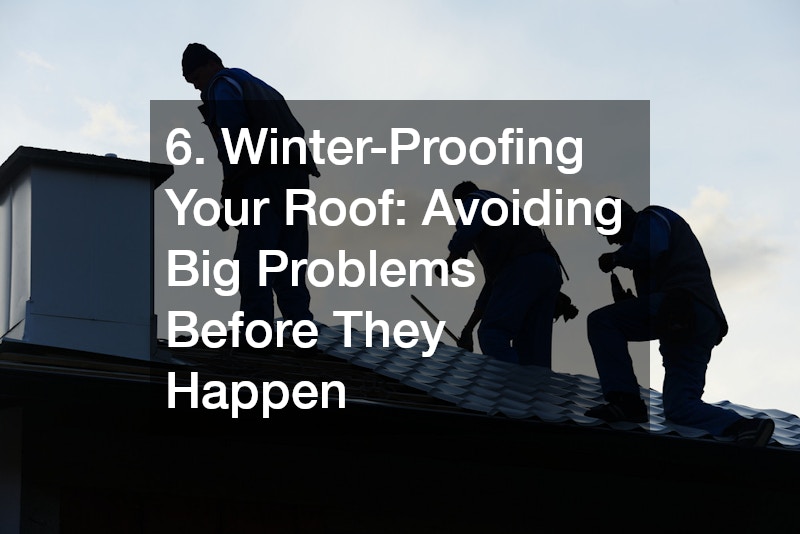As a single mom, balancing family life, work, and home maintenance can be overwhelming. When winter rolls in with its chilly winds and unpredictable weather, it can feel like a whole new set of responsibilities is added to your plate. But fear not! Winterizing your home doesn’t have to break the bank or take up all your time. With a few simple steps, you can keep your house warm, safe, and cozy for the whole family. By following this winterizing your home checklist, you’ll be ready to tackle the season with confidence.
1. Seal the Deal: Insulating Windows and Doors

One of the most straightforward and cost-effective ways to winter-proof your home is by ensuring that your windows and doors are properly sealed. Gaps and cracks around these areas are significant culprits in allowing cold drafts to enter, which can make your heating system work overtime and lead to higher energy bills. Fortunately, there are several simple solutions to address these issues, many of which can be done on your own with minimal investment.
Window Insulation:
Weatherstripping:
A classic and affordable method, weatherstripping involves placing strips of material around the edges of windows to create a tight seal. This prevents drafts from sneaking in and can make a noticeable difference in keeping your home warm.
Window Film:
Window insulation film is a clear plastic film that sticks to the inside of your window frames, providing an extra layer of insulation. It helps reduce heat loss while still letting sunlight in. This is especially useful for older windows or in areas with extreme cold.
Insulated Curtains or Blinds:
Another effective option is installing thermal curtains or blinds. These are made from materials that help keep the warmth in and the cold out, and they can also help reduce heat loss during the night. Some models even come with a reflective coating for added insulation.
Double-Glazing:
If your windows are particularly old and drafty, you may want to consider upgrading to double-glazed windows. While this can be a more significant investment, it offers excellent long-term insulation benefits and can help improve the overall energy efficiency of your home.
Door Insulation:
Draft Stoppers:
Draft stoppers are simple yet highly effective tools that block drafts at the bottom of your doors. You can purchase them or make your own by filling a fabric tube with materials like rice, sand, or even old fabric scraps. These are particularly useful for exterior doors.
Weatherstripping:
Just like with windows, doors need proper weatherstripping to prevent cold air from slipping in around the edges. Check all doorframes to make sure they are tightly sealed and replace any worn-out weatherstripping.
Door Sweeps:
Another solution is installing a door sweep, which attaches to the bottom of your door and helps seal the gap between the door and the floor. This can be particularly effective for doors that are prone to drafts.
Storm Doors:
Installing a storm door over your exterior door adds an extra layer of insulation, especially in areas prone to extreme winter weather. Storm doors help keep the cold air out and protect your primary door from the elements.
For a more permanent solution to any cracks or gaps around your windows and doors, consider professional caulking services. These services can effectively seal areas that are difficult to address with DIY solutions, such as tiny gaps around window frames or door jambs. Additionally, if you want to ensure that hard-to-reach spaces around your windows and doors are sealed properly, you might want to contact a spray foam insulation company. Spray foam insulation can be applied to the smallest cracks and gaps, creating a strong barrier that keeps the cold air out and helps maintain the warmth inside.
2. Keep the Heat In: Maintain Your Heating System

It’s essential to ensure that your heating system is functioning efficiently to keep your home warm and comfortable throughout the winter. A well-maintained system not only saves you money on energy bills but also helps avoid unexpected breakdowns during the coldest months.
HVAC System Maintenance:
Regular maintenance of your HVAC system is crucial for ensuring it operates smoothly throughout the winter. Schedule professional HVAC system repairs to inspect and clean the system, replace filters, and check for any underlying issues that might affect its performance. Proper upkeep can improve efficiency, reduce energy consumption, and extend the life of your system, ensuring your home stays cozy all season long.
Furnace Checkups:
If you rely on a furnace for heat, it’s important to schedule a professional inspection before the cold weather sets in. Over time, furnaces can accumulate dust and debris, which can reduce their efficiency. If your furnace is showing signs of trouble, scheduling a furnace repair can prevent breakdowns and ensure that it’s running at its best, keeping your home warm and comfortable without consuming excess energy.
Change the Filters:
One of the simplest and most cost-effective ways to maintain your heating system is by replacing the air filters regularly. Clogged filters restrict airflow, causing your HVAC system or furnace to work harder and use more energy. Changing filters every 1–3 months, especially during winter, will improve airflow and help your system run more efficiently.
Duct Cleaning:
Dust, dirt, and allergens can accumulate in your ducts over time, reducing airflow and hindering the performance of your heating system. Scheduling duct cleaning annually ensures that the air circulating throughout your home is clean, and it can improve the efficiency of your heating system. Clean ducts allow for better airflow, reducing the strain on your system and lowering your energy bills.
By maintaining your HVAC system and scheduling regular furnace repair when necessary, you’ll ensure your home stays warm and your heating costs remain manageable throughout the coldest months.
3. Managing Home Heating Costs: Energy-Saving Tips for Single Moms

Heating costs can quickly become one of the largest expenses during the winter months. As a single mom, managing these costs while keeping your family comfortable can feel overwhelming, but with a few thoughtful strategies, you can save on energy bills without sacrificing warmth. Here are some practical and effective tips to help you reduce your heating expenses this winter.
Programmable Thermostat:
Set It and Forget It:
A programmable thermostat is a simple yet effective way to regulate your home’s temperature without constant manual adjustments. By setting specific temperatures for different times of day, you can ensure your home is warm when needed but avoids excessive heating during periods of inactivity, such as when you’re at work or the kids are at school. This prevents energy wastage and lowers your monthly heating bill.
Lower Temps at Night:
One of the easiest ways to save on heating costs is by lowering the temperature at night when everyone is bundled up in blankets. Setting your thermostat to a cooler temperature while you’re sleeping can result in significant savings over the winter months. For added comfort, consider using heated blankets or thick comforters to stay warm while reducing the heat in your home.
Regular Heating System Maintenance:
Change Filters:
Keeping your heating system running efficiently is essential for saving energy. A clogged or dirty filter reduces airflow, causing the system to work harder and use more energy. Make it a habit to check and replace your furnace filter regularly—at least every 1–3 months, especially during the colder months. This will help your system run more efficiently, saving you both energy and money.
Bleed Radiators:
If your home uses radiators for heat, be sure to bleed them periodically. Trapped air inside the radiator can prevent the heat from circulating properly, forcing the system to work harder. By releasing the air, you’ll improve the heating efficiency and reduce the energy needed to warm your home.
Evaluate Your Home Heating Oil Options:
Find the Best Deal:
For homes that rely on oil heat, it’s important to choose a home heating oil provider that offers competitive rates and reliable service. Some companies offer discounts for bulk purchasing or subscription plans. It’s worth researching and comparing providers to find the best deal, as switching to a more affordable provider can result in substantial savings over the winter season.
Consider a Service Plan:
Many heating oil providers offer service plans that include regular maintenance checks and emergency repairs. These plans can help reduce unexpected costs and ensure your system runs efficiently all winter long, keeping heating costs manageable.
Water Heater Efficiency:
Lower the Temperature:
Your water heater could be a significant source of energy consumption in your home. Reducing the temperature on your water heater to 120°F is typically sufficient for most household needs and can save you money by reducing the energy used to heat water.
Water Heater Repairs:
If your water heater is outdated or malfunctioning, it could be using more energy than necessary. Scheduling a water heater repair can fix inefficiencies that lead to higher energy consumption. Regular maintenance and timely repairs can extend the life of your water heater and keep it running efficiently, saving you money in the long run.
By following these energy-saving tips, including setting a programmable thermostat, maintaining your heating system, and choosing the right home heating oil provider, you can effectively manage your heating costs while keeping your home warm and your family comfortable during the winter months.
5. Protecting Pipes from the Freeze: Tips You Can’t Ignore
Frozen pipes are a major concern during the winter months, especially in areas that experience extreme temperatures. When water freezes inside pipes, it can expand, leading to leaks or even bursts that can cause significant damage to your home. Fortunately, there are several preventative measures you can take to safeguard your pipes and prevent these costly problems.
Pipe Insulation:
Foam Pipe Insulation:
One of the most effective ways to prevent frozen pipes is by insulating them. Foam pipe insulation is a simple and inexpensive solution that can be wrapped around exposed pipes, especially those in unheated areas such as basements, crawl spaces, attics, and garages. This insulation helps maintain the temperature of the pipes, preventing them from dipping below freezing. It’s an easy DIY fix that can save you from dealing with costly water damage later.
Heat Tape:
For pipes that are particularly vulnerable to freezing, electric heat tape is an excellent option. Heat tape wraps around your pipes and provides a consistent, gentle heat source that keeps them warm enough to prevent freezing. This is especially useful for outdoor pipes, pipes in colder parts of your home, or any areas where temperatures tend to drop significantly.
Temperature Control:
Keep Cabinet Doors Open:
During extremely cold weather, open the cabinet doors beneath your kitchen and bathroom sinks to allow warm air to circulate around the pipes. This is especially important for pipes that are located along exterior walls or near windows, as these areas are more likely to experience temperature fluctuations. By allowing warm air to reach the pipes, you reduce the likelihood of freezing.
Let Faucets Drip:
In particularly cold weather, a slow drip from faucets can prevent water from freezing inside the pipes. Letting both hot and cold faucets drip just a little bit ensures that the water keeps moving, making it harder for ice to form in the pipes. While this may slightly increase your water usage, it’s a small price to pay to prevent a pipe burst.
Other Preventative Measures:
Seal Gaps and Cracks:
Check for any cracks or gaps around your pipes, particularly in areas like basements, attics, or crawl spaces. If you notice any openings, use caulk or foam sealant to close them. This helps to prevent cold air from directly reaching your pipes, which can lead to freezing. Additionally, weatherproofing these areas can increase the overall energy efficiency of your home.
Pipe Heating Systems:
For homes in areas with extreme cold, you might consider installing a full pipe heating system. These systems are designed to maintain a consistent temperature along your pipes, offering more comprehensive protection than heat tape or foam insulation alone. While this may require a larger initial investment, it can be especially helpful for homes in climates prone to extreme winter weather.
Professional Help:
If you find yourself dealing with frozen pipes or water damage from a burst pipe, don’t hesitate to call plumbers for assistance. Professional plumbing services can identify weak spots in your system and offer solutions, such as pipe relocation or more advanced insulation options, to ensure your pipes stay safe during future winters. It’s always better to prevent damage before it happens, but having a trusted plumber on hand can help you recover quickly if a problem does arise.
By taking these simple yet effective steps to protect your pipes, you can ensure that your home stays safe and warm all winter long. Whether it’s insulating pipes, controlling temperatures, or calling in professional help, these preventative measures can help you avoid the hassle and expense of dealing with frozen or burst pipes.
6. Winter-Proofing Your Roof: Avoiding Big Problems Before They Happen

Your roof is one of the most critical parts of your home, especially during the winter months. It acts as the first line of defense against harsh weather elements like snow, ice, and wind. When your roof is well-maintained, it can better withstand these conditions, preventing costly damage. Here are some essential tips to help you winter-proof your roof and avoid big problems before they arise.
Roof Inspection:
Check for Leaks:
The first step in winter-proofing your roof is ensuring it’s free from any existing leaks. Leaks can worsen during winter when snow and rain seep into small gaps, causing significant water damage to your home. Inspect your roof for missing, cracked, or curled shingles that may allow water to penetrate. If you find any signs of damage, it’s best to address them immediately to prevent further complications. Even minor issues can escalate into costly repairs during the winter season if left unattended.
Inspect Flashing and Seals:
Flashing around chimneys, skylights, and vents can deteriorate over time, leading to water leaks. Check that the flashing is securely in place and there are no gaps or cracks around the seals. If you find any issues, have them sealed or replaced before the weather turns colder.
Professional Roof Inspection:
If you’re unsure about the condition of your roof or can’t access certain areas, it’s a good idea to call in a professional roofer to conduct a thorough inspection. A roofer can spot potential issues that may not be visible to the untrained eye and can help ensure your roof is ready for the harsh winter months.
Clean Gutters:
Clear Debris and Ice:
Clean gutters are essential for effective roof drainage. Leaves, twigs, and other debris can easily clog your gutters, causing water to back up and freeze. This can lead to ice dams, which form when melting snow refreezes in the gutters and creates a barrier. Water trapped behind these ice dams can leak into your home, causing water damage to your ceilings and walls. Regularly cleaning gutters and downspouts is a simple way to prevent this problem. Consider using a ladder to reach your gutters or hiring a professional for a thorough cleaning.
Install Gutter Guards:
If you live in an area with a lot of trees, installing gutter guards can help prevent debris from accumulating in your gutters. These mesh or screen systems allow water to flow freely while keeping leaves and twigs out. By reducing the buildup of debris, gutter guards can help ensure your gutters stay clear throughout the winter.
Prevent Ice Dams:
Insulate the Attic:
One of the key factors in preventing ice dams is making sure your attic is properly insulated. Without adequate insulation, warm air from your home can escape into the attic and cause snow on your roof to melt. The water then refreezes at the roof’s edge, forming ice dams. By insulating your attic and ensuring proper ventilation, you can prevent this issue. Additionally, consider installing baffles in your attic to allow for better airflow and prevent warm air from accumulating near the roof.
Use a Roof Rake:
After a heavy snowfall, use a roof rake with a long telescoping handle to remove snow from the edges of your roof. This can help reduce the weight of the snow and prevent ice dams from forming. Make sure to use the rake gently to avoid damaging your shingles. If you’re not comfortable doing this yourself, a roofer can help remove excess snow or ice buildup safely.
Install Heat Cables:
Another way to prevent ice dams is by installing heat cables along the edges of your roof. These cables melt snow and ice as it accumulates, allowing water to flow freely off the roof and into the gutters. While this can be a more expensive solution, it’s an effective method for homes that are prone to ice dam formation.
Shingle Maintenance:
Replace Missing or Damaged Shingles:
Before winter hits, check for any missing or damaged shingles on your roof. Winter weather can exacerbate existing problems, and missing shingles can leave your roof vulnerable to leaks. If you find any damaged shingles, replace them immediately to ensure your roof remains watertight.
Ensure Proper Ventilation:
Proper ventilation is another critical component of maintaining your roof during the winter. Ensure your attic has enough vents to allow warm air to escape, which can help prevent moisture buildup that could lead to mold and rot. A well-ventilated attic also helps regulate the temperature of your roof, reducing the likelihood of ice dams.
By performing these essential roof maintenance tasks and seeking professional help when needed, you can ensure that your roof is prepared to face the winter months. Whether it’s inspecting for leaks, cleaning your gutters, or installing heat cables, these proactive steps will help you avoid the headaches and costs of winter roof damage.
Final Thoughts
Winterizing your home doesn’t have to be a daunting task. With small, budget-friendly changes like sealing drafts, maintaining your heating system, and preparing for power outages, you can reduce stress and keep your family comfortable and secure. Each step you take now can prevent costly repairs later, giving you more time to focus on the things that matter most—spending quality moments with your loved ones and enjoying the cozy season without unnecessary worry.

